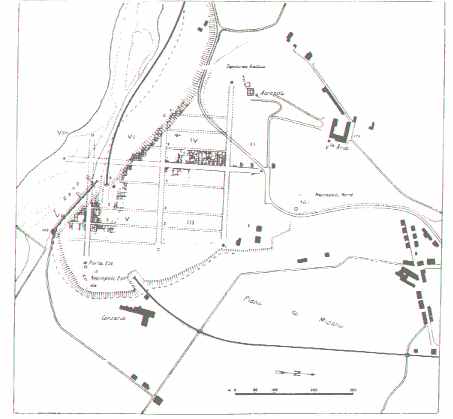
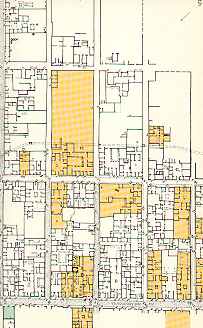
The Foundation of Etrusco-Italic Cities and the Division of Urban Territory
(part one)
by Thanchvil Cilnei
Introduction
In order to get a view on the foundation of Etrusco-Italic cities and the processes involved, which is as complete as possible, we have to collect three types of information: information from historical, archaeological and literal (Greek and Latin) sources. Information, obtained from classical literature, has been the main source for historical research, whereas archaeology has been used to verify or falsify this information. In the meantime, history and literature have proved to be useful sources of explanation when archaeology provided findings and data, which couldn't be identified immediately. Within the study of the process of origin and development of settlements in antiquity, the three fields of history, literature and archaeology can go hand in hand to provide detailed data on this matter, from which important answers can be generated. The question here is not that much the anthropological one ("Why do urban settlements occur and develop from a certain point in time?"), but more: what is known from written and archaeological sources about the process of planning and ritualism within the foundation and development of cities in ancient Italy, of which literal sources stand, that the founding- and building system handled by the Etruscans has been of great influence during a long period of time. Next, there is the question: which forces were important regarding the development of Italic urban settlements, once they had been founded?
In this article, I hope to give some insight into what is known from written and archaeological sources about the process of planning and ritualism within the foundation and development of cities in ancient Italy and the role of the Etruscans within this process.
The Builders: a historical and literal analysis
In the Roman tradition, the Etruscans were known as "the builders of Italy's cities". Also the tradition goes, that Romulus founded the city of Rome etrusco ritu, so: according to the directions of Etruscan priests. There is a quote in the work of Plutarch to state this:
Plutarch. Rom. 11: "Romulus made a beginning with the foundation of the city. He had sent for men from Etruria to direct every action within the founding with certain sacred offerings and rules and to teach how it was prescripted in the Sacred Law."
Varro (1st century B.C.) even mentions, that only cities, founded "etrusco ritu", had the right to be called Urbs (Varro, L.L. 5.143) and he calls Rome an explicit example of such a city. Dionysius of Halicarnassus mentions, that the Romans, even in his own age, used the "Etruscan Rite" when they founded their colonies:
Dion.Hal. I, 228: "This is why this custom of confinement of land in the foundation of cities lives forth with the Romans."
According to Varro, Roman colonies in the oldest periods were called "urbis",
Varro, L.L. 5.143: ".....quod item conditae ut Roma..." ("because they have been founded in the same manner as Rome").
Remains of Etruscan cities and city walls confirm that this "Roman" tradition was not without base. In the oldest periods, the Etruscans naturally used far more simple means of fortification, but it is a fact that the skill of building cities with strong fortification walls is narrowly linked to the role played by the Etruscans in Italy. Because they formed a numeral minority as far as warriors are concearned, they ruled their territory from their fortified cities. The big and strong polygonal structured walls have been found predominantly in regions, which were ruled or strongly influenced by the Etruscans (Delbrück, R., Das Capitolium von Signia, 1903, p. 14-17).
Excavations in
Marzabotto also have shown, that the building of Roman colonies and army cities
("castra"), just like the Roman temple and the Roman house, go back to
Etruscan prototypes. Marzabotto was an Etruscan colony from the 6th century B.C.
with a Hippodameic city plan of rectangular streets and blocks. As far as
temples and houses are concearned: the building and orientation of the earliest
Roman temples go right back to those of Etruscan temples (see: temple plans and
remains in Etruscan cities and settlements like Veii, Tarquinia, and Sta.
Marinella Punta della Vipera
The early, original form of the Roman atrium-house goes back to types of atriumhouses, found in the interior of Etruscan tombs from the 7th century B.C. onwards.
The following pictures show the resemblances of Etruscan and Roman city plans, temples and houses:


Marzabotto (Graeco-Etruscan) to the left and Pompei (Samnite-Roman) to the right.

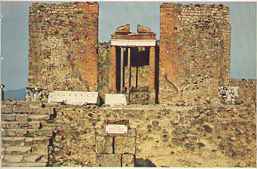
An Etruscan temple to the left and the Roman temple of Fortuna Augusta at Pompei to the right.
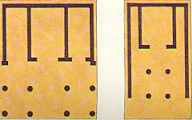
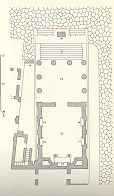
Two plans of Etruscan temples to the left and the plan of a Roman temple to the right.
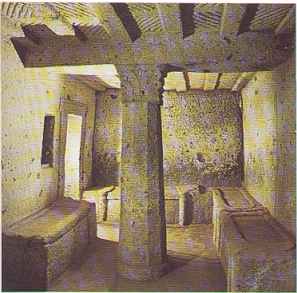
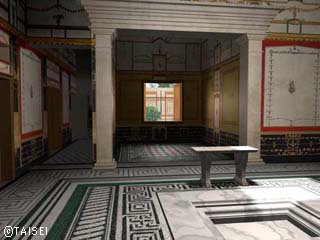
The atrium-house interior of an Etruscan tomb to the left and the interior of a Roman atrium-house to the right.
W. Schulze (Zur Geschichte lateinischer Eigennamen, 581 f; Roma, Gründung der etruskische Gens Ruma, 218 und 518 ff: Ramnes Tities Luceres, etruskische Gentilnamen) published a theory, in which it is assumed that even the name ROMA would be directly derived from the Etruscan language. Usually, the explanation of this name has been sought in the adaptation by the Etruscans of the Greek (i.e. Corinthian-Dorian) word "Rhômè/Rhômà", which would have become "Rûmà" in Etruscan and "Rôma", used by the local population, the Romans. By the way, the word in Greek means "force". So, instead of the usual explanation, Schulze's theory was, that the name RUMA (>Roma) was given immediately by the Etruscans and that Etruscan clans had been directly involved in the foundation of Rome.
If it is so, that the art of city planning and building was an art learned by the Romans from the Etruscans, this information is not that important within the range of time, as the power of the Etruscans gradually fell in favor of the rising power of the Romans and the culture of the Etruscans was, certain important details notwithstanding, overthrown by that of the Romans. What is very important, however, when we take a look at what remained from the Etruscan civilization within the Roman civilization, is that the Etruscan way of founding, planning and building cities (like other aspects of the Etruscan civilization) is a striking example of the adaptation of a part of the Etruscan culture by the Romans, without any alterations whatsoever. The thought might have been that, when the Romans copied some part of Etruscan culture that was considered sacred, it was not to be altered in any way. Even when the Etruscan civilization was considered dead by the Romans, these customs and rituals (next to certain religious, political and legal customs, rules and rituals) lived on within their own culture. As far as the fact of founding cities in Italy is concearned, it is not that important that the Romans took those customs and rituals from the Etruscans, for that they did this is known, but more important is: how did they found, plan and build cities? For a lot of that information will lead us more or less directly to information that has been lost on the Etruscan way of doing this.
Diving into this matter means diving into historical literature of the ancient times. The following ancient authors mentioned or described the rites apllying to the foundation of a city and the Etruscans are mentioned in relation to this matter:
Varro, L.L. 5.143; Macrobius, Sat. 5.19.13; Livius, AUC 1.44.3; Plutarchus, Rom 11
Mentions and descriptions of the foundation of Rome and Roman cities are furthermore done by:
Cato, fr.Orig. 1.18 (Serv. Aen. 5.755); Festus 302; Festus, ep. 236; Serv.Dan.Aen. 4.212; Isidorus, Orig. 15.2.3, referring to: Aen.3.109 and Aen. 1.425; Donatus Terent. Ad. 4.2.44; verg. Aen. 5.755, 7.157 ("ipse humili designat moenia fossa": he himself points out the wall with a humble gully"); Manilius, Astr. 4.555 ("...iunctisque iuvencis moenia succinctus curvo describet aratro, aut sternet positas urbes": "...and after having joked the cattle he will describe the wall, surrounded by the curving of the plough, or will he lay out the positions of cities."); Cicero, Phil. 2.40.102 ("tu [Antoni] autem insolentia elatus omni auspiciorum iure turbato Casilinum coloniam deduxisti, quo erat paucis annis ante deducta, ut vexillum tolleres, ut aratrum circumduceres: cuius quidem vomere portam Capuae paene perstrinxisti, ut florentis coloniae territorium minueretur.": "you [Antonius], however, elated by insolence and after having thwarted every law of the sacred omens, have brought down Casilinum to be a colony, where it had been brought to few years before, in order to pick up the banner, to lead the plough around it: with its phore you almost thrashed the Capuan gate, so that the territory of a blooming colony would be threatened.")
The following quotations are from the "Corpus Inscriptionum Latinarum" (CIL) and the "Lex Coloniae Genetivae Iuliae" (LCGI):
CIL X, 3825: Iussu Imp. Caesaris qua aratrum ductum est ("at the command of the Imperator Caesar, wherever the plough has been led.")
CIL VI, 1233: Collegium augurum auctor[e] Hadriano...terminos pomerii restituendos curavit ("a committee of augures, at the instigation of Hadrianus,.....took care of bringing back the [original] boundaries of the pomerium.")
LCGI c 73 (Bruns Fontes p. 127): ne quis intra fines oppidi coloniaeve, qua aratro circumductum erit, hominem mortuum inferto (" let no one within the boundaries of a town or colony, where it is surrounded by the plough (techn. term for: legally founded), bring a dead man.").
The Ritus Etruscus
Dionysus of Halicarnassus and Plutarchus are some of the Greek historians, who describe the matter of Roman city foundation and the role of the Etruscans herein. Whether the Etruscans have been mentioned in all of the quotations above or not, the modus operandi in the Ritus Etruscus, described in the various texts is more or less the same. The exact procedure will be described further on, according to two ancient historians, but the most important component of the Ritus Etruscus was the confinement of the area where the actual city would rise. That this must have been a very old part of the ritual ceremony can be deduced from the prescription that the part of the plough going into the soil had to be made of some kind of metal. The plough as an instrument used to confine areas points to an agricultural civilization, like the mythical story about the one who was said to have given the Etrusca Disciplina to the Etruscans, the god-like Tages, who was born out of a ploughing phore. The Ritus Etruscus, i.e. the Etruscan laws by which a city had to be founded, was part of the Disciplina Etrusca, written down in the so called "Libri Tagetici".
Thulin has collected all Latin quotations dealing with the Ritus Etruscus. He found out that most ancient Latin quotations go back to the works of Cato and Varro. According to the data he found in these works, he could make the following synopsis of what happened during the foundation rite of cities:
"The founder yoked, dressed in a toga which was plied in the Gabinian way(1) and on a day set by the auspicia(2), a white bull and a white cow(3) [in front of a plough]: the cow was yoked to the left, the bull to the right(4). According to old Tagecian custom, the scissors of the plough had to be made of metal(5). The founder then would lead the yoked couple around: he would let the bull walk on the outward bound side of the future city and the cow on the inward bound side(6). He would thus describe a square(7), to be more specific: an unceased, equal phore(8). The tail of the plough was held oblique in order to get the ploughed soil always on one side(9). This line of heaped soil would thus mark the place of the future city wall, the phore would mark the place and course of the future fossa(10). At places where gates had to be erected, the plough would be hieved up and carried over these places(11). Through this sacred rite of ploughing the wall would be sacred, the gates would be profane, because they would be built on a piece of land which had not been ploughed according to the sacred rite(12)."
Notes:
1. Cato, fr. Orig. 1,18: Serv. Aen.V,755: incincti ritu Gabino
2. Varro,LL V,143: die auspicato
3. Ovid. Fast. IV,819: alba iugum niveo cum bove vacca tulit
4. Cato, op.cit.: taurum in dexteram, vaccam intrinsecus iungebant
5. Macrob. Sat. V,19,13: et Tuscos aeneo vomere uti, etc.
6. Cato, op.cit.; Serv. Dan. Aen. IV, 212; Müller,K.O.,Etrusk.II,148: dextratio; Lydus de mens. IV,73.
7. Dion. Hal. I,228,88: "making a square"; Plut.Rom.11 described a circle.
8. Fest. ep. 236: primigenius sulcus
9. Varro LL V,143: interiore aratro; Cato,op.cit.: tenebant stivam incurvam, ut glebae omnes intrinsecus caderent; Plut. op.cit.
10. Cato, op.cit.; Varro,op.cit.
11. Cato,op.cit.; Isid. Orig. XV,2,3; Donat.Terent. ad IV, 2,44.
12. Plut.op.cit.; Fest. 285: qua sanctitate muri, quo iure portae (sanctitas: holy law; ius: profane law)
The origin of this foundation ritual is not certain. The question is: were the Etruscans the inventors of these rituals or had they copied them from other peoples? From ancient Hellas (Greece) nothing is known about foundation rites, although there was a myth concearning the foundation of Thebes. The founder of this city, Kadmos, ploughed the land and sowed dragon's teeth. From these rose giants, the first creatures to live there and build the city. Kadmos came from the Middle East, he was a Phoenician. Nevertheless, ancient Greece must have known some ways to seal the foundation of an important city. According to Curtius (IV 8, 6), Alexander the Great would have used a Macedonian city foundation rite when he founded Alexandria in Egypt. In this rite, he used flour to mark the direction of the future city wall.
The Egyptians and Chaldaeans used to throw building offerings in the stone pit where the stone blocks for the city walls were hacked out. An offering like that was brought by the Etruscans and Romans at the so called mundus. We will discuss this item in Etruscan and Roman city building in another article. In connection to this, above mentioned, city ritual in Egypt, an obscure and interesting inscription was found in pharaoh Newoser-Re's temple, saying: "the king is digging out the foundation pit; together with a goddess he brings an offering above the foundation pit...". An inscription in Chorsabad, in which king Sargon describes the foundation of his palace, says: "The people threw their amulets...". Something similar is described by Ovid in his Fasti, when he describes the foundartion ritual concearning Rome:
Ovid. Fast. IV 819: fossa fit ad solidum, fruges iaciuntur in ima (" a ditch is made into solid ground, fruits are thrown into the depth of it."
A similar quotation is made in Greek by Plutarch in his "Vitae parallellae", in the book about Romulus. Excavations at Niniveh have pointed out the traces of numerous small offerings in between the remains of the city walls, which prove that the inhabitants of the city took part in the offering celebration connected to the foundation of the city. The city foundation ritual, as performed by the Etruscans and Romans, using a plough, has been attested nowhere else in the ancient Western and Mediterranean world than in these regions (i.e. Etruria and Rome). In the literature of India, however, the ploughing of a phore to mark a holy place or sanctuary is known. In the so called Mahavamsa, "the Great Chronicle", in which is told how Sri Lanka became a Buddhist country (in 307 B.C.), the foundation of Anuradhapura is described as follows:
" After having bowed in courtesy before the Theras (i.e. high priests), he proceeded, surrounded by them, towards the river, ploughing on his way with a golden plough, doing this to mark the boundaries of the new sanctuary. In front of the plough the noble State Elephants Mahapuduma and Kunjana had been yoked."
Feilberg ("Ordbog over jyske Almuesmål, II 850) remarks that the ploughing of land, in Nordic countries, had the function of averting all kinds of misfortune and disease or to free people taken away by mountain ghosts. Mannhardt ("Wald- und Feldkulte, 1904, I 553 ff) remarks that in those ancient Nordic cultures the ploughs were occasionally pulled by young girls.
So far the first episode of our studies. The next articles will deal with the following aspects of ancient Etruscan and Roman cities: the pomerium, the sulcus primigenius and the mundus.